7.11: Conjugate Carbonyl Additions - The Michael Reaction
- Page ID
- 443821
After completing this section, you should be able to
- explain how the carbonyl group which is present in α, β-unsaturated aldehydes and ketones activates the carbon-carbon double bond so that it is susceptible to attack by nucleophiles.
- write equations to illustrate the addition of lithium diorganocopper reagents to α, β-unsaturated aldehydes and ketones.
- identify the product formed from the reaction of a given α, β-unsaturated aldehyde or ketone with a given lithium diorganocopper reagent.
- identify the α, β-unsaturated aldehyde or ketone, the lithium diorganocopper reagent, or both, needed to prepare a given product through a conjugate addition reaction.
- write an equation to illustrate the Michael reaction.
- write a detailed mechanism for a given typical Michael reaction.
- identify the product formed in a given Michael reaction.
- identify the reagents necessary to synthesize a given compound by a Michael reaction.
- Michael reaction
Notice the wide variety of compounds that can take part in conjugate addition/Michael reactions. As usual, you should not feel overwhelmed by the number of different compounds that can be used, just keep in mind that in all cases the mechanism is essentially the same.
You may be confused about the designation of the product from the conjugate addition to an α, β-unsaturated aldehyde or ketone as a 1,4 adduct. You can more clearly understand this name if you recognize that the proton added in the second step of the reaction first adds to the oxygen of the enolate ion to produce an enol. The latter then tautomerizes to the more stable keto form.
One of the largest and most diverse classes of reactions involves nucleophilic additions to a carbonyl group. As you learned in CHM 222, carbonyl carbons are electrophilic due to bond polarity created by resonance.

We have discussed a nucleophilic addition to carbonyl carbons called a 1,2 addition. During 1,2 addition the nucleophile adds to the carbonyl carbon which is defined as the one position. Subsequently, hydrogen adds to the carbonyl oxygen which considered the two position. Overall an atom is added in both the 1 and 2 position justifying the reaction name, 1,2 addition.
Basic Reaction of 1,2 Addition
An important functional group is created when an alkene is placed in conjugation with a carbonyl. These conjugated carbonyl are called enones or α, β-unsaturated carbonyls. The term α commonly refers to the carbon adjacent to a carbonyl and β referrers to the next carbon in the chain.
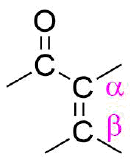
Conjugation transmits the electrophilic character of the carbonyl carbon to the β-carbon of the α, β-unsaturated carbonyl double bond. The resonance structure shown below shows that the electronegative oxygen atom in α, β-unsaturated carbonyls pulls electrons away from the β carbon making it more electrophilic than a typical alkene carbon.
From this resonance form, it should be clear that nucleophiles may attack either at the carbonyl carbon or at the β-alkene carbon. These two modes of reaction are referred to as 1,2-addition and 1,4-addition respectively. A 1,4-addition is also called a conjugate addition.
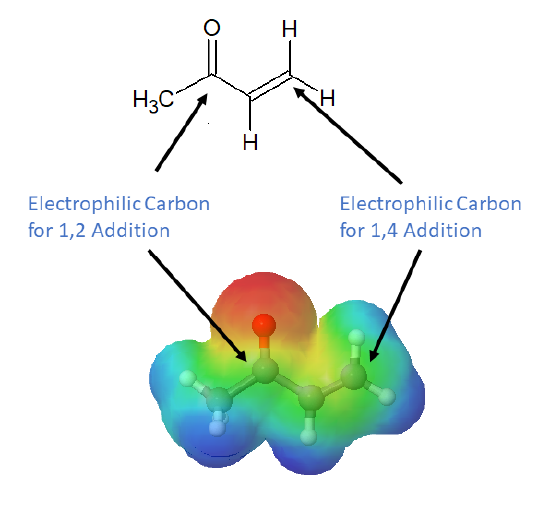
Basic Reaction of 1,4 Conjugate Addition
In 1,4 addition, a nucleophile is added to the carbon β to the carbonyl while a hydrogen is added to the carbon α to the carbonyl. Overall, the carbonyl is unaffected by the nucleophilic addition. It is important to note that this reaction only occurs because the alkene is conjugated with a carbonyl. The utility of 1,4 conjugate addition is shown below by the nucleophiles that enable carbon-carbon bond formation via this addition to α,β-unsaturated carbonyls.
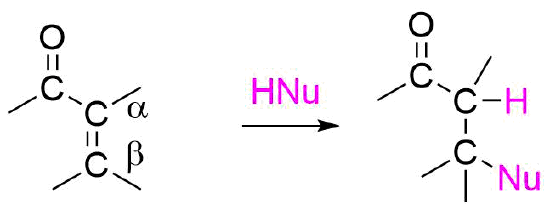
General Mechanism for 1,4 Conjugate Addition
The mechanism starts with the nucleophile attacking the electrophilic β carbon forming a single bond. The two electrons from the alkene pi bond are pushed onto the electronegative carbonyl oxygen creating an enolate. In the next step the the enolate is protonated to form an enol. If the original nucleophile was neutral, this addition will cause it to become positively charge. A proton transfer will occur making the nucleophile neutral and turning the enolate into an enol. If the original nucleophile was negatively charged this protonation is accomplished by the subsequent addition of a proton source. The product of the second step of the mechanism shows why the reaction is called a 1,4 addition. The nucleophile bonds to the β alkene carbon which is considered the one position and the hydrogen adds to the carbonyl oxygen which is in the four position. Overall, addition occurs in the one and four position. In the final step of the mechanism, the enol undergoes a rearranges to form a carbonyl during a process called tautomerization. Tautomerization causes the hydrogen to move from the oxygen to the β-carbon.
1) Nucleophilic attack (Note: The Nu in the product should have a positive charge.)
2) Protonation
3) Tautomerization
Predicting the Products of a 1,4 Conjugate Addition.
In total, 1,4 addition occurs across the alkene bond of the α,β-unsaturated carbonyl. The alkene pi bonds is broken to form two single bonds, one on the α-carbon and one on the β-carbon. During 1,4 addition, the α-carbon of the α,β-unsaturated carbonyl forms a bond with a hydrogen while the β-carbon forms a bond to the nucleophile. Remember that neutral nucleophiles typically lose a hydrogen during 1,4 addition.
1,2 Vs. 1,4 Addition
Whether 1,2 or 1,4-addition occurs to a α,β-unsaturated carbonyl depends on multiple variables but is mostly determined by the nature of the nucleophile. During the addition of a nucleophile there is a competition between the formation 1,2 and 1,4 addition products. If the nucleophile is a strong base, such as Grignard reagents or metal hydrides, both the 1,2 and 1,4 reactions are irreversible and therefor are under kinetic control. Since 1,2-additions to the carbonyl group are fast, we would expect to find a predominance of 1,2-products from these reactions. If the nucleophile is a weak base, such as, water, alcohols or amines, then the possible 1,2 addition is usually reversible. This means the competition between 1,2 and 1,4 addition is under thermodynamic control. In this most cases, the 1,4-addition product dominates because the stable carbonyl group is retained.
Nucleophiles Which add 1,2 to α, β-Unsaturated Carbonyls
Metal Hydrides (LiAlH4)
Grignard Reagents
Organolithium Reagents
Example
Gilman Reagents
Another important reaction exhibited by organometallic reagents is metal exchange. Organolithium reagents react with cuprous iodide to give a lithium diorganocopper reagent, which often is referred to as a Gilman reagent. Remember that organolithium reagents are formed by a reaction of lithium metal with an organohalide. Lithium diorganocopper reagents are considered a source of carbanion like nucleophiles similar to Grignard and organolithium reagents. However, the reactivity of lithium diorganocuprate reagents is slightly different and this difference will be exploited in different situations. Diorganocuprate reagents are made from the reaction of two equivalents of an organolithium reagent and copper (I) iodide (CuI). The created lithium diorganocuprate reagent acts as a source of R:-
Lithium Diorganocopper (Gilman Reagent)
General Reaction
Example
Formation of Lithium Dimethylcopper
Reaction of 1,4 Conjugate Addition of Gilman Reagents to α, β Unsaturated Ketones
Lithium diorganocopper reagents, R2CuLi, undergo 1,4 conjugate addition when reacted with α,β-unsaturated ketones. Using lithium diorganocopper reagents allows for a wide range of organic groups to undergo this 1,4 conjugate addition including alkyl, aryl, and alkenyl groups. Because a C-C single bond is formed this reaction is an excellent method for adding to the carbon framework of a ketone.
Example
Mechanism for the 1,4 Conjugate Addition of Lithium Diorganocopper Reagents to α, β-Unsaturated Ketone
This mechanism is only slightly different than the general mechanism for 1,4 conjugate addition described above. The mechanism starts with the nucleophilc diorganocopper anion (R2Cu-) adding to the electrophilc β alkene carbon forming a Cu-C bond. The R group from the diorganocopper is then transferred to the β alkene carbon with elimination of a neutral organocopper species (RCu). Protonation of the enolate ion followed by tautomerization creates the final 1,4 addition product.
Synthesis of Ketones using 1,4 Conjugate Addition of Lithium Diorganocopper Reagents to α, β Unsaturated Ketones
When using retrosynthetic analysis to plan the synthesis of a ketone, remember this reaction allows for the formation of a C-C bond between third and fourth carbon away from a ketone. The carbonyl group in the target molecule will become an α,β-unsaturated carbonyl in the probable reactant. To determine the structure of a possible reactant, start by cleaving the C-C between the third and fourth carbon away from the carbonyl to create two fragments. The take the fragment which retains the carbonyl and remove a hydrogen from the second carbon and connect the second and third carbon with a double bond. The creates the required α,β-unsaturated carbonyl reactant. The other fragment will become the lithium diorganocopper reagent. Remember the lithium diorganocopper reagent contains two of the required R group. Note! If the fourth carbon away from the ketone in the target molecule is tertiary or quarternary there may be multiple bonds which could be retrosynthetically cleaved.
How would you make the following molecule using a conjugate addition of a Gilman reagent to an α,β-unsaturated ketone?
- Answer
-
Michael Reaction
Certain nucleophiles undergo conjugate addition with the alkene of an α,β-unsaturated carbonyl compounds rather than undergo direct nucleophilic addition with the carbonyl. During conjugate addition, a nucleophile adds to the electrophilic β-alkene carbon to from a C-Nuc bond. If the starting materials contains an ester the corresponding alkoxide is used as the base in the reaction. Otherwise a hydroxide base, such as sodium or potassium hydroxide, is commonly used.
General Reaction

When enolate nucleophiles undergo conjugate addition with an α, β-unsaturated carbonyl the process is called a Michael Reaction. The Michael reaction works best with particularly acidic enolate donors such as malonic esters, β-keto esters, etc. Enolates which are weaker acids tend to undergo nucleophilic addition to the carbonyl rather than conjugate addition. For example, malonic ester’s acidic alpha-hydrogens can be easily deprotonated by sodium ethoxide to form an enolate. The enolate adds to propenal to form the conjugate addition product.
Example
Predicting the Product of a Michael Reaction
During the is reaction the C=C pi bond of the α,β-unsaturated carbonyl is broken. An C-H bond is formed on the carbon in the α-position from the carbonyl. An acidic hydrogen is removed from the nucleophile and then it is used to form a C-C bond with the carbon in the beta position from the carbonyl.
a. In the first step, remove the double bond and add two single bonds
b. Add a hydrogen to the bond adjacent to the carbonyl
c. Add the nucleophile to the other end of the double bond (remember to remove a hydrogen from the nucleophile)
What would be the product of the following conjugate addition?
- Answer
- 1. break the double bond and add two single bonds
- 2. Add a hydrogen to the bond adjacent to the carbonyl
- 3. Remove a hydrogen from the nucleophile.
- 4. Add the nucleophile to the other end of the double bond.
Mechanism of Michael reaction
During a Michael reaction the enolate acts as a nucleophilic donor and the α, β-unsaturated carbonyl acts as the electrophilic acceptor. The mechanism is a mixture of an alpha-substitution for the enolate and a conjugate addition for the α, β-unsaturated carbonyl.
Notice that the Michael Reaction does not require the deprotonation of the product to push the reaction towards completion. The reaction is thermodynamically favorable because the C-C bond formed in the product is stronger than the C=C bond in the starting material. This means that, unlike the Claisen condensation, this reaction only requires a catalytic amount of reaction base.
1) Deprotonation
The alkoxide base removes an alpha-hydrogen to from an enolate nucleophile.
2) Nucleophilic attack on the carbon β to the carbonyl
The enolate nucleophile then adds to the electrophilic β-carbon of the α, β-unsaturated carbonyl. Conjugation pushes the C=C pi bond electrons onto the carbonyl oxygen, forming a new enolate enolate.
3) Protonation
The alkoxide is protonated, forming an enol.
4) Tautomerization
Tautomerization converts the enol back into a carbonyl forming the neutral conjugate addition product.
The Michael reaction can be performed with a wide variety of α, β-unsaturated carbonyl electrophilic acceptors and enolate donors. Michael acceptors such as α, β-unsaturated ketones, aldehydes, esters, amides, and nitro compounds can all participate in this reaction. Michael donors with particularly acidic α-hydrogens, such as β-diketones, β-keto esters, β-keto nitriles, α-nitro ketones, malonic esters, and nitro compounds can be used.
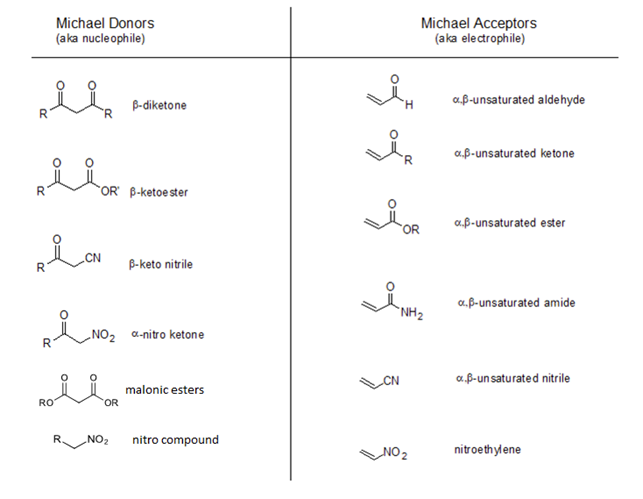
Table 7.1: Possible Donors and Acceptors Which can be used in a Michael Reaction
Stereochemical Consideration of Micheal Reactions
During a Michael reaction two sp2 hybridized carbons are both converted to sp3 hybridization. Both of them have the possibility of creating a chiral carbon. Michael reactions are often performed using an α, β-unsaturated carbonyl with only hydrogen substituents on the alkene to prevent the formation of chiral carbons. If either carbon in the alkene has an alkyl substituent it will likely form a chiral carbon in the Michael reaction product. The α-carbon of the enolate donor also has the possibility of forming a chiral carbon.
Planning a Synthesis Using a Michael Reaction
The true utility of the Michael reaction is seen when considering it use in a synthesis. The reaction can be used to prepare aldehydes, ketones, esters, amides, nitriles, and nitro compounds. A target molecule can possibly be made using a Michael reaction if it contains one of these functional groups and an alkyl chain at least three carbons long. The key bond cleavage is a C-C bond between β and gamma carbons from a carbonyl-like group. The fragment with the Y group loses an α-hydrogen and then forms a C=C bond between the α and beta carbon. The carbon of the other fragment gains a hydrogen. This fragment should possess an acidic α-hydrogen and should be made up of Michael donor fragments such as those listed in Table 7.1. In some cases, there may be more than one fragmentation variation. Each variation should be investigated and the possible starting materials compared for viability.
How could the following molecule be synthesized using a Michael Reaction?
- Answer
-
Pathway 1
Starting Materials 1
Pathway 2
Starting Material 2
Solution
When comparing the two sets of possible starting materials of pathway 1 are preferred. The Michael enolate donor is particularly acidic because its conjugate base is stabilized by two carbonyls. The Michael enolate donor for pathway 2 does not have the same acidity. Consequently, the enolate would preferably undergo nucleophilic addition rather than conjugate addition. The makes the starting materials of pathway 1 preferred for the synthesis of the starting material.
In combination with alkylations and condensations, the Michael reaction may be used to construct a wide variety of complex molecules from relatively simple starting materials. The carbon nucleophiles used in the following examples include cyanide ion, sodium diethylmalonate and the conjugate base of cyclohexane-1,3-dione. These anions are sufficiently stable that their addition reactions may be presumed reversible. If this is so, the thermodynamic argument used for hetero-nucleophile additions would apply here as well, and would indicate preferential formation of 1,4-addition products. Cyanide addition does not always follow this rule, and aldehydes often give 1,2-products (cyanohydrins). In each case the initial reaction is a Michael addition, and the new carbon-carbon bond is colored magenta. Any subsequent bonds that are formed by other reactions are colored orange.
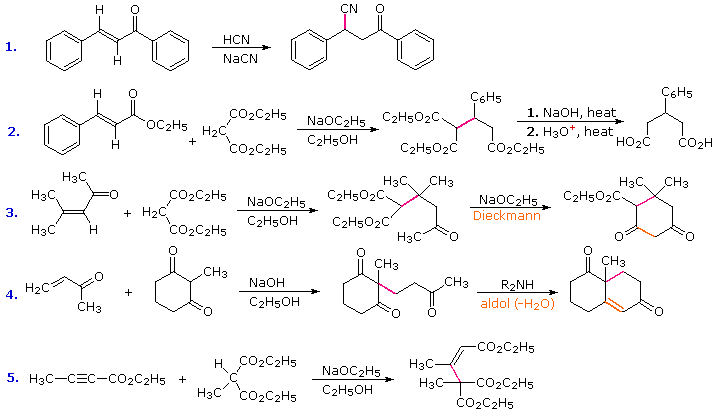
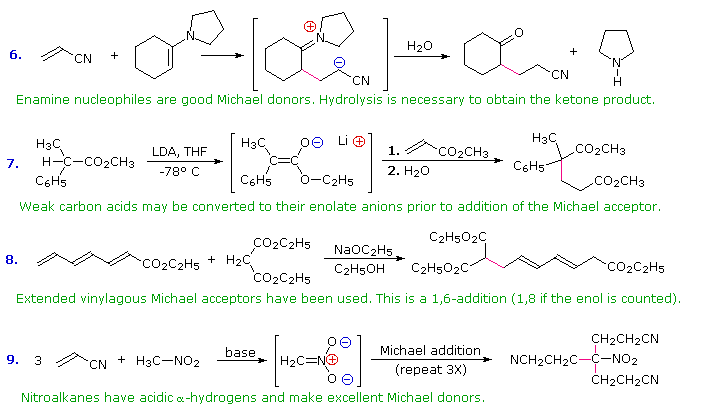
Provide the products of the following Michael additions:

- Answer
-
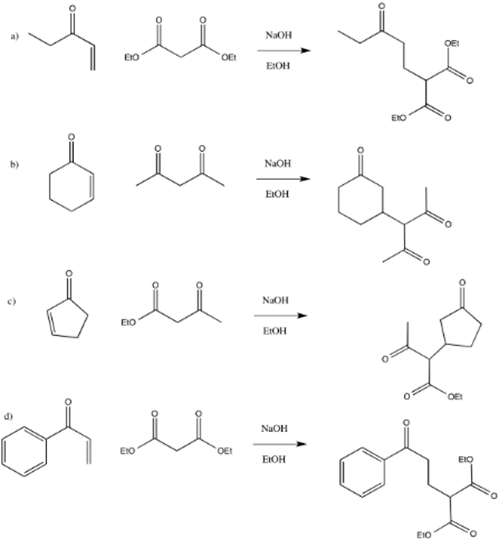
What would be the starting materials required to make the following molecule using a Michael reaction? Red = Oxygen, Grey = Carbon, White = Hydrogen, Blue = Nitrogen.
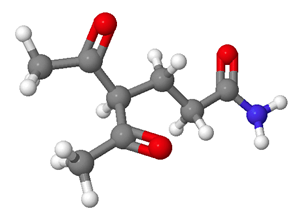
- Answers

